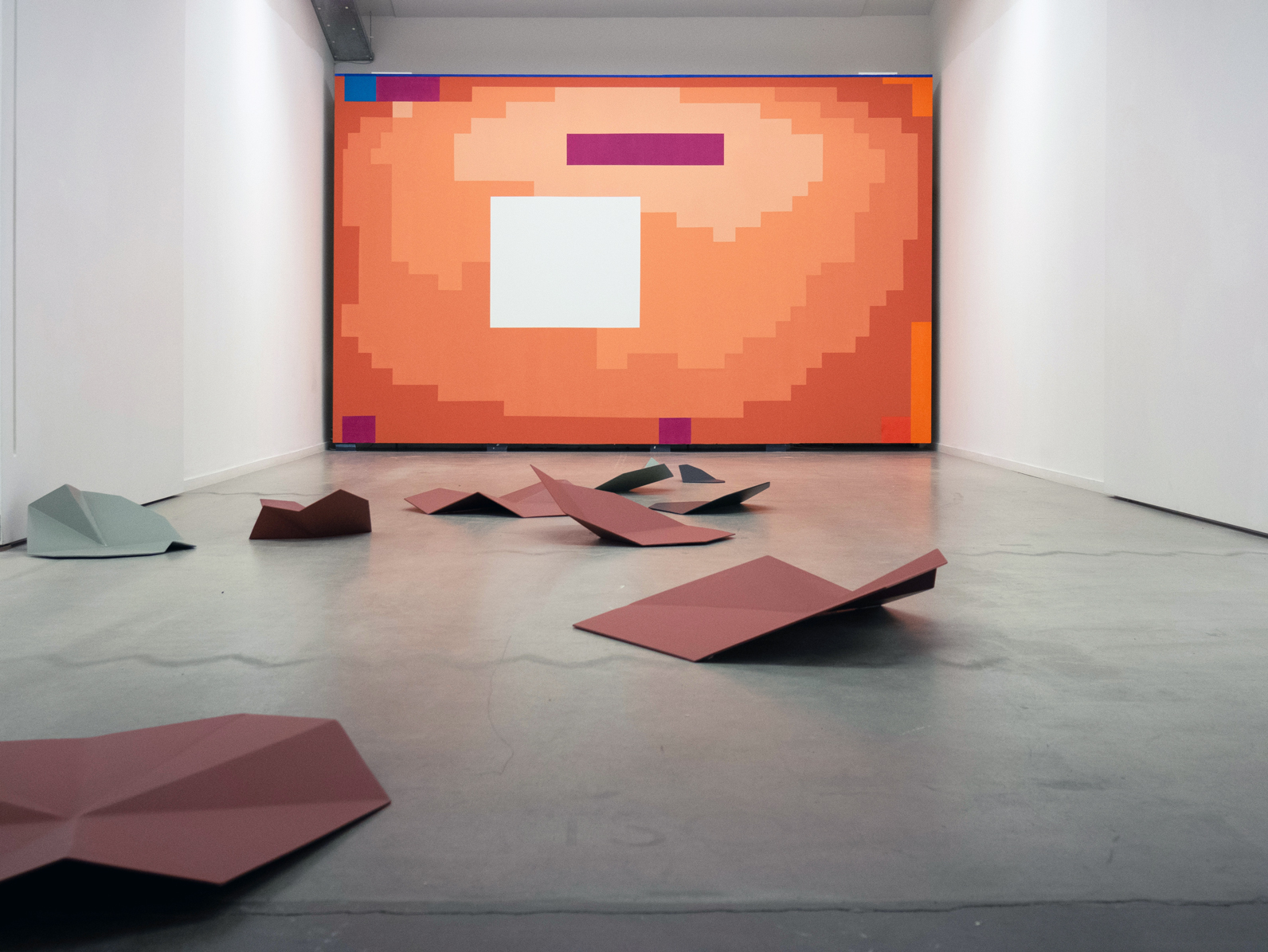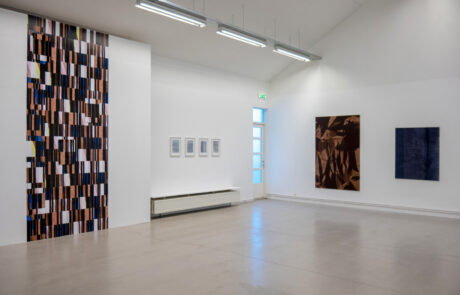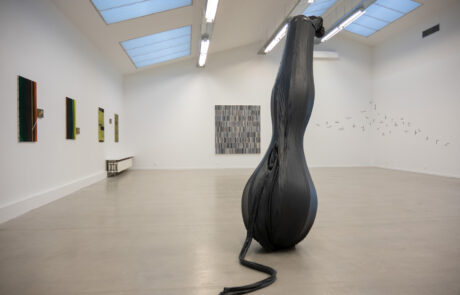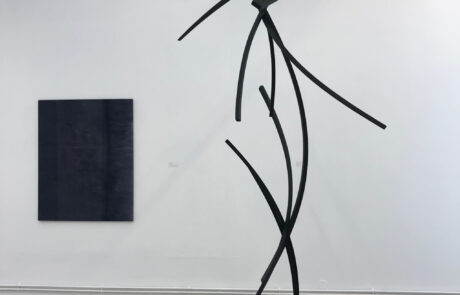
DIFFERENT ECHOES
April 13 – June 2, 2019
Art flourishes in a social context; that applies both to social cooperation between artists, and no less to the dialogue that takes place between the art and the observer. In the spring of 2015 Nicola Dimitrov invited Ekkehard Neumann, Friedhelm Falke and Sigrún Ólafsdóttir to show their work with him in an ample space in an old factory building in Heusweiler in Saarland, where he has a studio. That informal little show led to a joint project, which would grow in scale. The artists discerned in the work a common thread which interested them, and which they wanted to pursue and allow more people to enjoy. The first stage was to invite artists Annette Wesseling and Elly Valk-Verheijen to join the group. The paths of the artists had crossed before, and they were familiar with each other’s works and methods, and that laid a firm foundation for their collaboration.
A united group of six artists was formed, all living in Germany, but originating from three countries: the Netherlands, Germany and Iceland. All had completed their art studies in Germany, while Elly Valk-Verheijen had started hers in the Netherlands and Sigrún Ólafsdóttir in Iceland. Together the artists developed an exhibition concept where the key theme is to bring out reciprocal echoes between the works, as they interact with different exhibition spaces, in a range of locations. The title of the project is Different Echoes. The artists have sought to collaborate with galleries and museums in Europe: a joint exhibition under the title Different Echoes was first held at the Gallery Meno Forma in Lithuania in 2016, followed by a number of galleries and museums in Germany. From Iceland the works will go on to Croatia. The exhibition does not always comprise the same works, and hence
it is not a touring exhibition as such: works are selected for each show in consultation with the local curator, taking account of the variable sizes of the venues. Subtle differences are thus seen from one exhibition to the next, always ensuring that the works reflect interesting ripples, different echoes, among themselves and with the venue which is the setting for each show.
A look at the works
Displaying the exhibition at the LÁ Art Museum provides a welcome opportunity to showcase artist Sigrún Ólafsdóttir in her former home territory (she is from nearby Selfoss), in the context of the works of her colleagues from where she now works, in Germany. Sigrún has lived in Saarbrücken since completing her postgraduate art studies at the Saar College of Fine Arts, where she had excelled – as witness her prize winning proposals for art in public spaces. Ólafsdóttir‘s art is often described as three-dimensional drawing in space, while the artist herself says that she is dealing with a sort of equilibrium between calm and chaos, stillness and motion, capturing a moment that may be disrupted at any time. Her aim is that each work should reflect balance, but also a tension entailed by the sense that it could collapse or move – thus reflecting the zeitgeist of uncertainty and mutability. In the works in this show she uses bentwood, often coated in black rubber, and gravity also has a part to play.
In the foyer works by Ólafsdóttir are displayed, from the series Rotation and Expansion. The works project from the wall. Together with their shadows, they form a refined calligraphy which flutters slightly, as if in a serene dance. In the large exhibition space, Gallery 1, Lucifer is seen, interacting with the works of all the other artists. Lucifer, a sculpture more than two metres tall, is, like the works mentioned above, made of bentwood and rubber. The piece depicts a creature with a tail, masculine and at the same time feminine, combining pliancy, erectness, and enigmatic feelings. In the innermost space, Gallery 3, are another two pieces by Ólafsdóttir, one from the Foreplay series, the other is Ritual. Foreplay comprises a number of pieces: mobiles suspended from the ceiling, again of bentwood and rubber – clusters which may be tightening into a knot or breaking away to swing free. Many of Ólafsdóttir’s works are ambiguous in meaning, evoking erotic ideas, or music and slow movements. Ritual is also a mobile made of bentwood, suspended from the ceiling where it moves slightly. The gentle motion and the title of the work give rise to spiritual thoughts; the form is also reminiscent of the Mikado pick-up-sticks game, which requires patience and perseverance, mental equilibrium and focus, if the whole edifice is not to collapse.
As in Ólafsdóttir‘s art, opposing concepts contend in the paintings of Friedhelm Falke – but not the same ones.
In Falke‘s case opposites such as discipline and flow, sharp and soft, objective and subjective, transparency and saturation, come to mind. The artist himself has commented that his works sometimes spring from random observations and meaningless glances in daily life. He is interested, he remarks, in capturing such ephemeral, unconscious moments in paintings. He works in a range of paint media, and in the exhibition he shows works made with acrylic and vinyl on muslin or paper, and tempera/oil-resin on wood; and he also exhibits a wall-installation made with adhesive tape.
In the large exhibition space are pairs of paintings by Falke. The overall title of the works is Context/, followed by the name of a fruit or vegetable: Context/Pears, Context/Onion and Lemon, Context/Lemon. Here he juxtaposes a small painting in tempera and oil-resin on wood with a much larger piece painted in acrylic and vinyl on cotton canvas: the former is a still life, while the latter is an abstract work, and the pair is united by a shared colour-palette. Falke has stated that his work on the Context series has given him a new perspective and other opportunities in the development of his painting. The comparison throws light on unexpected connections: at the same time as the abstract and the figurative become more real, the similarities are also highlighted. In Gallery 3 a comprehensive wall installation is displayed, in which colour tones run wild in brightly-hued adhesive tape that connects a variety of small acrylic and vinyl works on paper.
Before Nikola Dimitrov turned to painting, he had studied music and worked in the field for a time, and this is strongly reflected in his art. His paintings display reiterations of rhythm, variations on a theme in which the subtle variations of colour resemble the resonance at different volumes of a certain chord. The artist accentuates this still further in naming his works. Dimitrov uses pigments to mix his own paints, painting either on canvas or on paper. In his most recent works, Multivision, he has broadened his technique, adapting to new technology. Using a smartphone he takes pictures of his surroundings, which he “chops up“ using digital technology, then selects and assembles fragments of images which he prints on sheets of aluminium with Plexiglas or on a paper-like surface, each unit measuring 43 x 30 cm. They are then arranged into larger compositions which vary in size.
The work SoundSpace II from 2013 is a large painting by Dimitrov, a rhythmic piece in blue and earthy tones, comprising nine vertical lines filled with horizontal lines of varying width. The colours and lines produce a certain two-dimensional movement on the picture plane, a slow ferment. The show also includes paper work from the series, in which foreground and background establish depth with two colours, one painted over the other in an irregular but rhythmic alternation, revealing occasional glimpses of the paper beneath. The latest series, Multivision, on which he started work in 2018, is comprised of printed units in several versions, which offer various options of juxtaposition. While the technique is different, the composition is the same as in the SoundSpace series, with the addition of more experiments with form and colour. From this series the artist produces two installations in the exhibition: Balance on the wall by the café, and a work in Gallery 3 made of pieces titled In Progress A and B. These works are more complex in composition, while the rhythmic beat is present, giving an impression of movement, depth and cadence.
In two series of paintings by Annette Wesseling, the artist‘s experiments and choices in face of the caprices of nature are seen in contention – for the outcome is not determined by her alone, but also environmental factors, and time. In the series UV-Graphic she works with dyed cotton fabric, which she folds or crumples as part of the composition, before allowing the sun to shine on the piece, perhaps for many months, until the cloth is partly faded and various patterns emerge – variations on the original colour. The fabric is then mounted on a stretcher frame, and the work thus becomes also a documentation of environmental effect and time. Two works from the series are displayed in the exhibition, along with UV Graphic 86 (2014) in which raindrops and ink are added to the image. Environmental factors and time also play a part in another series, Meteo-Graphic. From that series the exhibition includes works of hand-made paper covered with delicate ink lines spaced below snowflakes which were left to thaw on the paper, on certain parts of the work.
Holo-Graphic is the title of yet another series by Wesseling. The exhibition includes two works (2016) from the series, painted in coloured ink on three-dimensional foil, with a continuous 3D pattern which also throws out multiple reflections of its surroundings. The import of the works is movement, as they change according to what the observer does, altering the light that falls on the work, and the reflections. A work in which the eyes play over the surface, while in return it piques the eyes.
Ekkehard Neumann, like Sigrún Ólafsdóttir, makes sculptures, but his materials are iron and steel, handled with geometrical formality. In his works the concepts of lightness and weight, open and closed space, are in contention, along with the works‘ dialogue with the space around. In the exhibition his sculptures form two installations which interact with the space. The works are untitled: one installation comprises iron wedges welded together into discs with a “folded“ surface that slants at different angles, coloured grey, red or black. The discs, of variable size, are scattered about the floor, mainly in Gallery 2 but also outside the space. Despite their strong mass and weightiness, their form is reminiscent of folded paper, and even gives the impression that the folded shapes may have flown into place like paper planes – despite the very different qualities and weight of iron and paper. Neumann has made similar pieces on a larger scale as outdoor artworks.
In the large exhibition space, Gallery 1, the other installation extends from the corner out onto the walls. Likewise untitled, it comprises many small geometrical forms in red or grey. These may recall some kind of lettering – signposts in the wilderness, or fragments of plans for a building, space or stair. The mind makes many connections, seeking to fill in the gaps.
Elly Valk-Verheijen, like Wesseling and Dimitrov, works with light, but in another way. The essence of her artistic work, she says, is exploration of light, the direction and reflection of the ray, time and space. For her works RED is My Hand she takes photos on her smartphone; the title is a reference to the smartphone, called a Handy in German. She uses the phone to take photographs in motion in a space in certain light conditions, where each change of position is a change of light, that also alters the colour. The works trapop 31.07.15 and trapop 26.2.18, for example, are taken of steps in a spiral stair, going upwards, each line representing one step. One work is from the time when the sun was high in the sky, the other low. The title, which references the act of mounting the stairs, also evokes the idea of an “optical trap,” alluding to Op Art. Other works from this series in the exhibition are MAGENTA Movement, Movement 20150420 and r2. After digital processing of the photographs, they are printed on Plexiglas. In each work the pieces of Plexiglas are held together by an aluminium plate, as arranged by the artist.
For all the group’s shows Valk-Verheijen has also made a site-specific wall piece. In the LÁ Art Museum the title of the work is Gallery 2, for its location. The import of these works is to bring out the subtle variations in the white colour of the gallery; while photographers and printers strive to make white walls as neutral as possible in the processing of photographs, Valk-Verheijen chooses to exploit the problems that arise from the neutrality of white. The process begins with a digital photograph of the location of the wall piece, without any use of filters, flash or digital adjustments. Digitally, she brings out exaggerated visual elements or pixels from the photograph, drawing information from the “white” surface with shapes and colours arising from the light conditions when the photo was taken. The outcome is a geometrical analysis of strict forms, closely related to the architecture of the place, the space and the gallery. For the work for the LÁ Art Museum the artist was sent a photograph of the wall taken during another exhibition. It was a low-resolution image, and thus the pixels or units were large, so the artist opted not to use a fragment of the image, but to use the whole picture on the entire wall. The empty space in the work corresponds to the painting that hung there.
Diversity
The works vary greatly in size and scale; they are made in a range of materials, and the themes are different. But the point of the exhibition is to achieve an equilibrium among these opposites. The artists’ works demonstrate that art is a process of research based on curiosity, experimentation, practice and repetition. Most of the works are abstract, and many display features of concrete or geometrical art, but they spring from other ideological roots. Figurative forms are seen in Friedhelm Falke’s art, and in the work of Elly Valk-Verheijen and Nikola Dimitrov photographs of organic forms such as a hand or a landscape are transformed into a geometrical colour-symphony. What unifies the works is their diversity, which makes for interesting juxtapositions, offering the observer an experience of echo and dialogue on many levels.
The diversity is also entailed in the ideological development of the works, which are made in mixed media – new or old – as well as sculptures, paintings, textile, graphic art, and installations of various kinds. Harmonies and echoes are seen and heard, spanning a wide scale of organic flow vs. disciplined formalism, soft vs. hard, calm vs. importunity, lightness vs. weight, to name but a few. Together the works interact and amplify each other, so that the observer has much to perceive, and will be rewarded with a meaningful response and dialogue, and can give, relate and receive if they care to do so.
Curator: Inga Jónsdóttir
Um listamennina:
Annette Wesseling
Annette Wesseling was born in 1966 in Münster, and now lives and has her studio in Köln, Germany. She graduated from the Münster Academy of Art 1993; in her final year she was a Meisterschüler (master student) under Ulrich Erben. She has received many awards for her art and participated in a large number of exhibitions – both solo and group shows in Germany and elsewhere in Europe. Examples of her work are in public and private collections.
Ekkehard Neumann
Ekkehard Neumann was born in 1951 in Oldenburg, and now lives and has his studio in Münster, Germany. He initially studied art history at the University of Göttingen before undertaking art studies at the Düsseldorf Academy of Arts, majoring in sculpture and also qualifying as a teacher. For the final year, 1977-78, he was a Meisterschüler (master student) under Paul Isenrath. Neumann taught art for a time, first in high school and later at the University of Münster. Neumann has curated a large number of exhibitions in Germany and abroad. Since 1996 he has been chair of the West German Artists‘ Association. He has shown his work in many exhibitions, both solo and group shows, and has participated in various sculpture projects and won prizes and awards. Examples of his work may be seen in public spaces, and also in public and private collections.
Elly Valk-Veheijen
Elly Valk-Verheijen was born in 1951 in Bergen, Netherlands, and now lives and has her studio in Dortmund, Germany. She graduated from the Vrije Academy of Arts in the Hague, Netherlands, in 1972, then studied at the Technical University of Dortmund 1984-89. She has a studio at Künstlerhaus Dortmund, an artist-run space for contemporary and experimental art, where she is chair. Valk-Veheijen is vice-chair of the West German Artists‘ Association. She has taken part in many exhibitions, both solo and group shows, all over Europe.
Friedhelm Falke
Friedhelm Falke was born in 1958 in Verden/Aller, Germany, and now lives and has his studio in í Köln. He studied art at the Braunschwei University of Art. He has won prizes and awards, and participated in many exhibitions, both solo and group shows, mainly in Germany but also elsewhere in Europe. Examples of his work are in many private and public collections, and he has also made a number of murals for public spaces.
Nikola Dimitrov
Nikola Dimitrov was born in 1961 in Mettlach/Saar, and now lives and has studios in Heusweiler near Saarbrücken and in Köln. He studied at the University of Music Saar, qualifying as a music teacher in 1984 and embarking on a career as a concert pianist in 1988. Since 2000 he has worked mainly as a painter, seeking to bridge the gap between music and visual art. Dimitrov has been very active in that field, organising events and taking part in many exhibitions, both solo and group shows, mostly in Germany.
Sigrún Ólafsdóttir
Sigrún Ólafsdóttir was born in 1963 in Reykjavík, and brought up in Selfoss, south Iceland. She now lives and has her studio in Saarbrücken, Germany. Sigrún graduated in 1989 from the Icelandic College of Arts and Crafts then pursued further studies at the Saar College of Fine Arts, where she was a Meisterschüler (master student) in her final year, 1994, under Wolfgang Nestler.Sigrún has received a range of awards for her work, including prizes in competitions for art in public spaces, where her works have attracted attention and been commissioned. She has shown her work in exhibitions in Iceland, but mostly in Germany, and elsewhere in Europe, in both solo and group shows. Examples of her work are in the collections of the National Gallery of Iceland, the Reykjavík Art Museum and Gerðarsafn – Kópavogur Art Museum in Iceland, and also in public and private collections in Germany.




